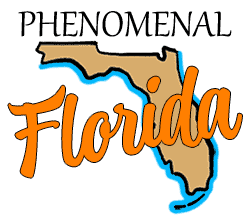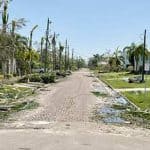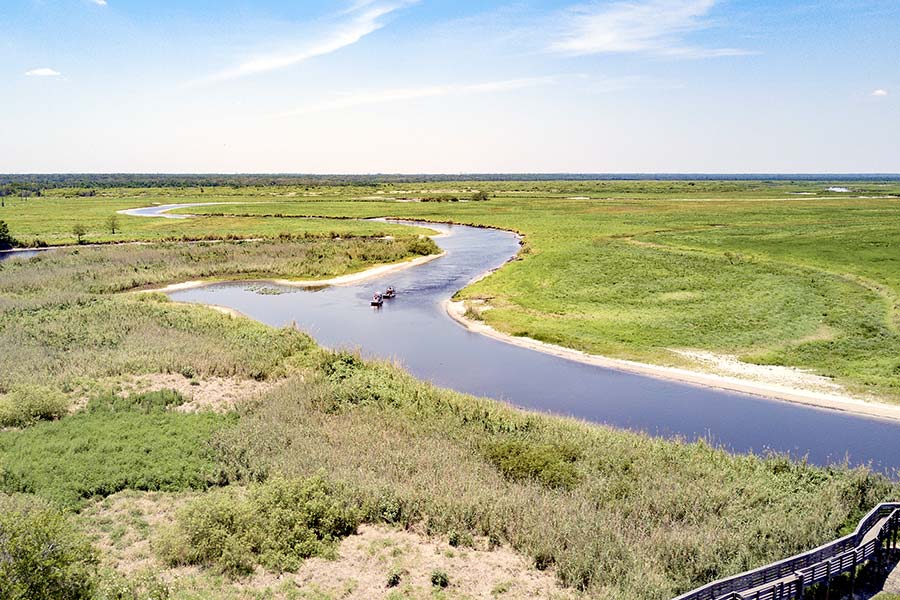
It seems like most rivers flow in a southerly direction, headed towards the equator from wherever they begin. However, one river in Florida actually flows northward. So what river in Florida flows south to north?
The St. Johns River is the longest river in Florida, and it flows south to north! It runs 310 miles from Blue Cypress Lake near Vero Beach to the Atlantic Ocean near Jacksonville. The river is ecologically and commercially important to Florida and is now being restored to its former glory.
So why does the St. Johns River flow backward? Is it a freshwater river? Is the fishing good on the St. Johns River? Read on to discover the interesting answers to these questions and more.
South to North: The Mighty St. Johns
The St. Johns River is a unique Florida river that flows south to north, and it begins at a place called Blue Cypress Lake. Formerly known as Lake Wilmington, Blue Cypress Lake is the largest in Indian River County. The lake covers about 6,500 acres at an average depth of about 8 feet.
Blue Cypress Lake is named after the way that its waters reflect the beautiful cypress trees that dot the shoreline. It is part of a large conservation area dedicated to preserving Florida’s wildlands.
Blue Cypress Lake is a vital component of an enormous wetlands ecosystem that includes marshes, floodplains, and runs of Florida plants like sawgrass and buttonbush. In fact, Blue Cypress Lake has one of the most extensive intact sawgrass marshes in Florida.
The Upper Basin
The St. Johns then flows into what is known as the river’s upper basin. The upper basin is characterized by an extensive network of shallow lakes, underwater streams, and marshes that feed the river.
This network of waterways is narrow, notoriously shallow, and very difficult to navigate. In addition, the slowly shifting water in the river channels can actually move entire sections of muck and aquatic plants, which adds another navigational challenge to the upper basin.
This part of the river is best accessed by airboat, as traditional boats will run aground or end up with a fouled prop.
While the upper basin is challenging to boaters, it is an essential part of Florida’s ecosystem. Before central Florida was paved over into massive cities, the network of marshes and swamps actually fed into the Everglades.
The massive swathe of plants and grasses made the entire central part of the state a giant filter that cleaned out water before it drained into the Gulf of Mexico. Even today, the upper basin acts as a massive filter that cleans the river’s water.
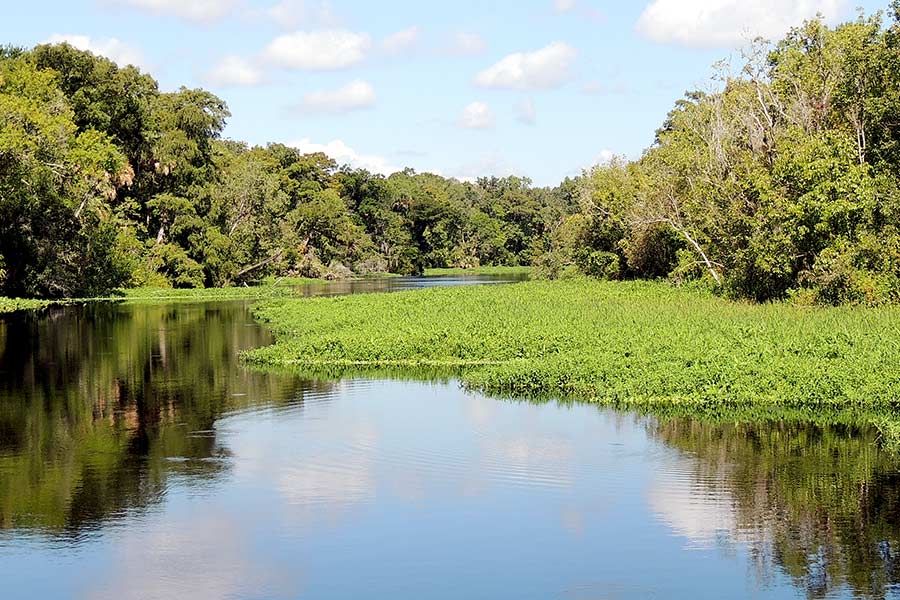
The Middle Basin
About twelve miles north of Titusville, the St. Johns transitions into the middle basin. The middle basin collects runoff and spring water from the lands of Volusia, Orange, Lake, and Seminole counties. In fact, drainage and runoff from the greater Orlando metro area feeds the St. Johns in the middle basin.
The middle basin is also where the fun begins. The river flows through Lake Monroe, near the town of Sanford, which is a convenient access point for boaters who wish to ride the St. Johns.
The U.S. Army Corps of Engineers maintains a navigable waterway beginning at Lake Monroe: this waterway is dredged, maintained, and marked by channel buoys and markers, making it very easy to navigate by boat.
If you follow the St. Johns north, you might get to see some neat wildlife. The area where the Wekiva River meets the St. Johns is home to a large population of black bears and even some rhesus monkeys. Nobody really knows where the monkeys came from, but some believe they are descended from monkeys used in filming an early Tarzan movie.
In addition to bears and monkeys, you’ll likely see some of Florida’s beautiful waterfowl and wading birds. The middle basin is also a splendid place to fish for bass, crappies, and more. There are more than 180 species of fish living in the St. Johns.
Phenomenal Florida Fun Fact: The first lake in the upper basin is known as Lake Hell ‘n Blazes, and it is named after the curses that early boaters would commonly shout while trying to navigate the tricky waters of the upper basin. It is sometimes printed on maps as “Lake Helen” or “Lake Hellen Blazes.”
Other Posts of Interest
- Is It Expensive To Live In Orlando?
- Is Port Canaveral And Cape Canaveral The Same?
- What Is The Difference Between Disney Springs And Disney Boardwalk?
- Is Tampa, Florida A Good Place To Live?
The Lower Basin
The river’s lower basin begins where the St. Johns meets the Ocklawaha River, about 100 miles from the Atlantic Ocean. The river becomes substantially larger as it approaches the ocean; near Lake George, the river widens to nearly half a mile, and it becomes almost 3 miles wide near Palatka.
The lower basin is home to some of Old Florida’s earliest and most historical settlements. People have lived in the lower basin since time immemorial. In American history, the area has long been important for commerce, as it was a convenient place for ferries and vessels to dock, and it made for an excellent transshipment point when the railroads began.
Today, the St. Johns remains critically important to the city of Jacksonville; the port brings more than a billion dollars annually to the economy and supports imports and exports of all kinds.
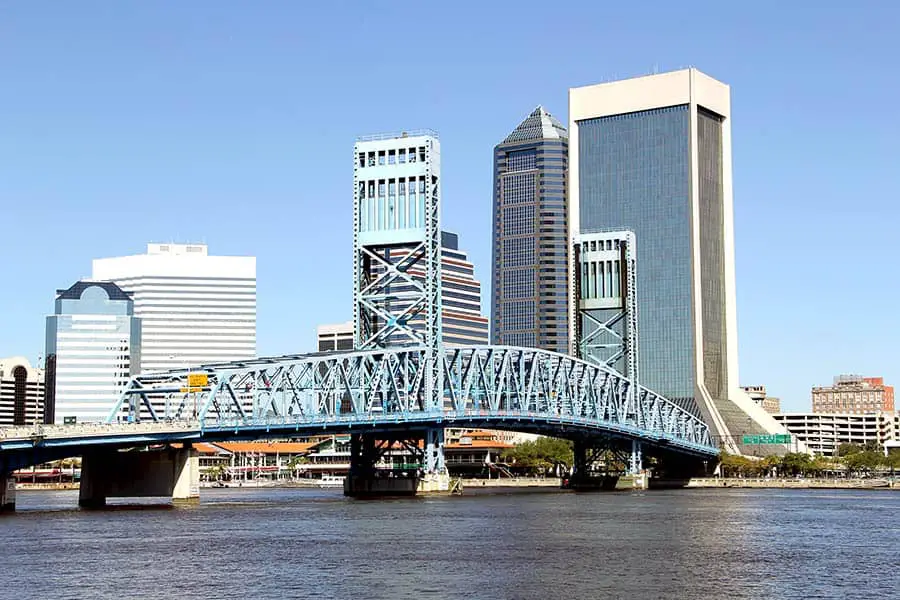
Why Does the St. Johns River Flow Backwards?
The St. Johns River flows backward because it is following the path of least resistance. The headwaters of the St. Johns River, down at Blue Cypress Lake, are about 27 feet higher than the terminus of the river, which is at sea level.
Water can’t flow south from Blue Cypress Lake because the elevation of the land rises to the south of the lake. However, flowing to the north, the river drops about one inch in elevation every mile.
Is the St. Johns River Freshwater or Saltwater?
The St. Johns River is a freshwater river. The headwaters of the river are mostly freshwater marshes and some sources of groundwater.
Much like the Suwannee River, the St. Johns River is considered to be “blackwater,” meaning that the water contains a lot of naturally occurring organic debris. As this rich river water approaches the Atlantic Ocean, it gradually becomes brackish and then salty.
Can You Boat on St. Johns River?
The St. Johns River is highly popular with boaters. On any given day, you’ll see a huge variety of watercraft on the river, ranging from waverunners and jet skis to airboats, pontoon boats, fishing boats, cruisers, and even houseboats. Of course, people also like to canoe and kayak along the river.
One of the most famous boating events on the St. Johns River is the Bassmaster fishing tournament. The Bassmaster tournament features events on many different bodies of water, including the St. Johns River.
The tournament can draw around 100 anglers on the river in their bass boats, hunting for these prized fish. Even if you don’t see the Bassmaster fishing pros in action, chances are you’ll spot a few Florida locals fishing for bass in the river on any given day.
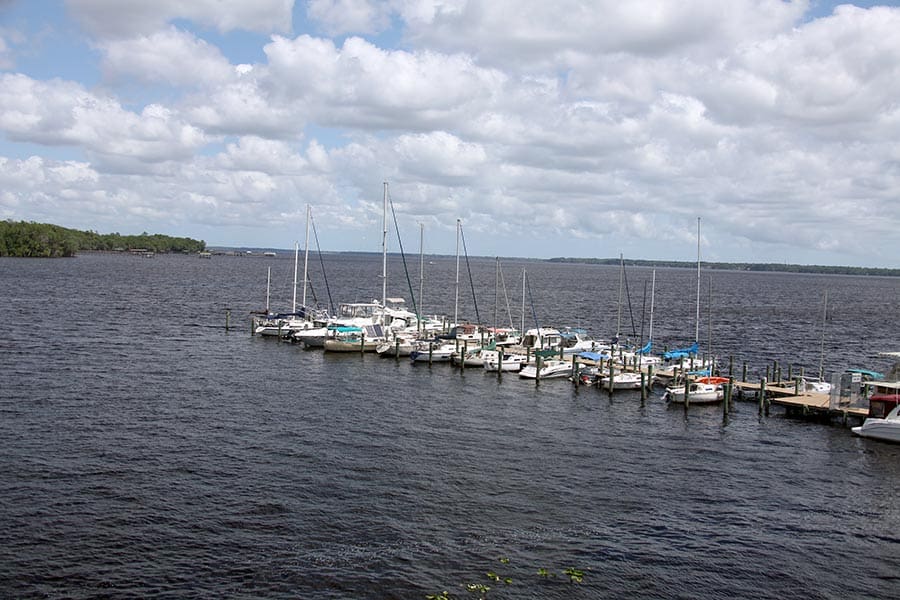
Are There Sharks in the St. Johns River?
Most sharks are considered stenohaline creatures, which is a fancy way of saying they can only tolerate a narrow range of salinity. And most of the waters of the St. Johns River are freshwater. So it would seem to follow that there are no sharks in the river – right?
As the St. Johns approaches the Atlantic Ocean, it becomes saltier. In the brackish and salty regions near the mouth of the St. Johns River, it’s not uncommon for anglers to reel in species like blacktip, sharpnose, or sandbar sharks. These species like to hunt around the mouth of the St. Johns and make for great sport. But that’s saltwater: are there sharks in the freshwater portion of the St. Johns River?
Yes. Bull sharks have special organs that help them regulate their body’s salinity, which means that they can survive just fine in freshwater. Bull sharks love the St. Johns River. It’s not uncommon to see them swimming around and hunting for fish, even in the freshwater regions of the river.
Is the St. Johns River the only River that Flows North?
Water always flows along the path of least resistance towards gravity, regardless of cardinal direction or which way the equator is from the headwaters. If the headwaters of a river happen to be south of low ground, the river will flow south to north.
The St. Johns River is one such river, but it’s not the only one. You might hear some Floridians say that the St. Johns River and the Nile are the only two rivers you will find in the world that flow north, but that’s an urban legend: there are dozens of north-flowing rivers on Earth. Among them are:
- The Bighorn River, in Wyoming and Montana;
- The Fox River, in Wisconsin;
- The Bann River, in Ireland;
- The Athabasca River, in Alberta, Canada;
- The Lena River, in Russia;
- The Saginaw River, in Michigan.
These rivers are only a partial list: there are dozens of other rivers that flow northwards. So while the St. Johns River is a remarkable body of water, it is definitely not the only river that flows north.
The St. Johns River: Florida’s Maverick Waterway
University of Florida researchers estimate that there are somewhere around 1,700 rivers and streams in Florida. The St. Johns River is one of the most important of the state’s many waterways. It’s not just a critical part of the ecosystem and a commercially important river; it’s also a spot where people go to enjoy fishing and boating – and it’s the only river in the state that flows to the north.
Whether you’ve come to see the sharks, ply the waters, or try your luck at bass fishing, you can enjoy knowing that you’re spending your day on a truly unique and fascinating body of water.
